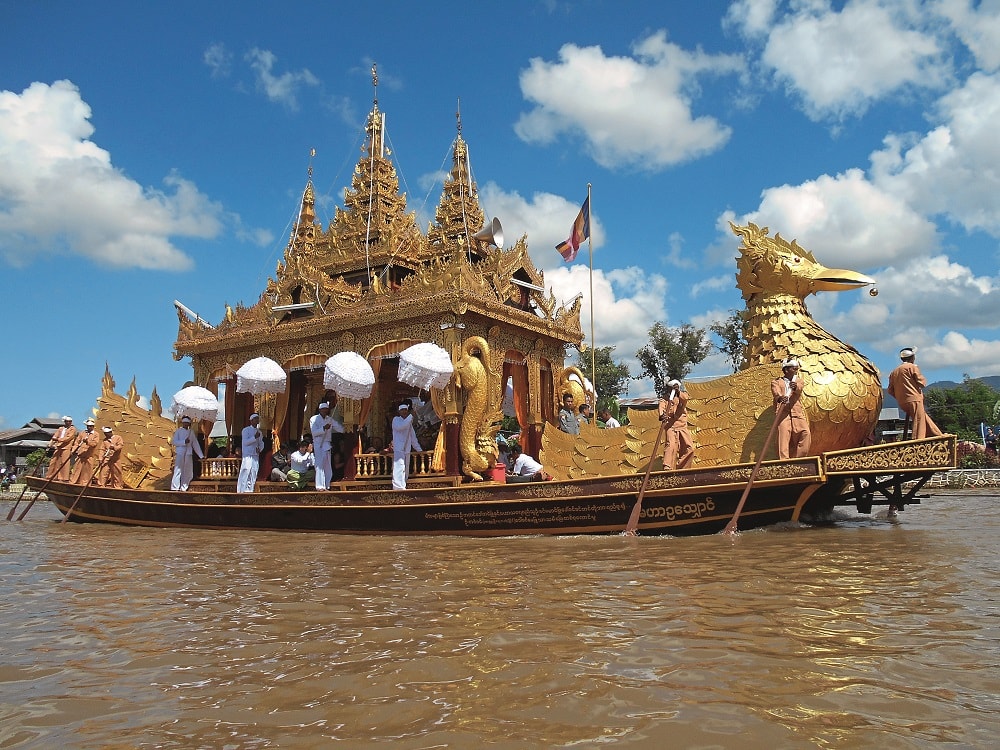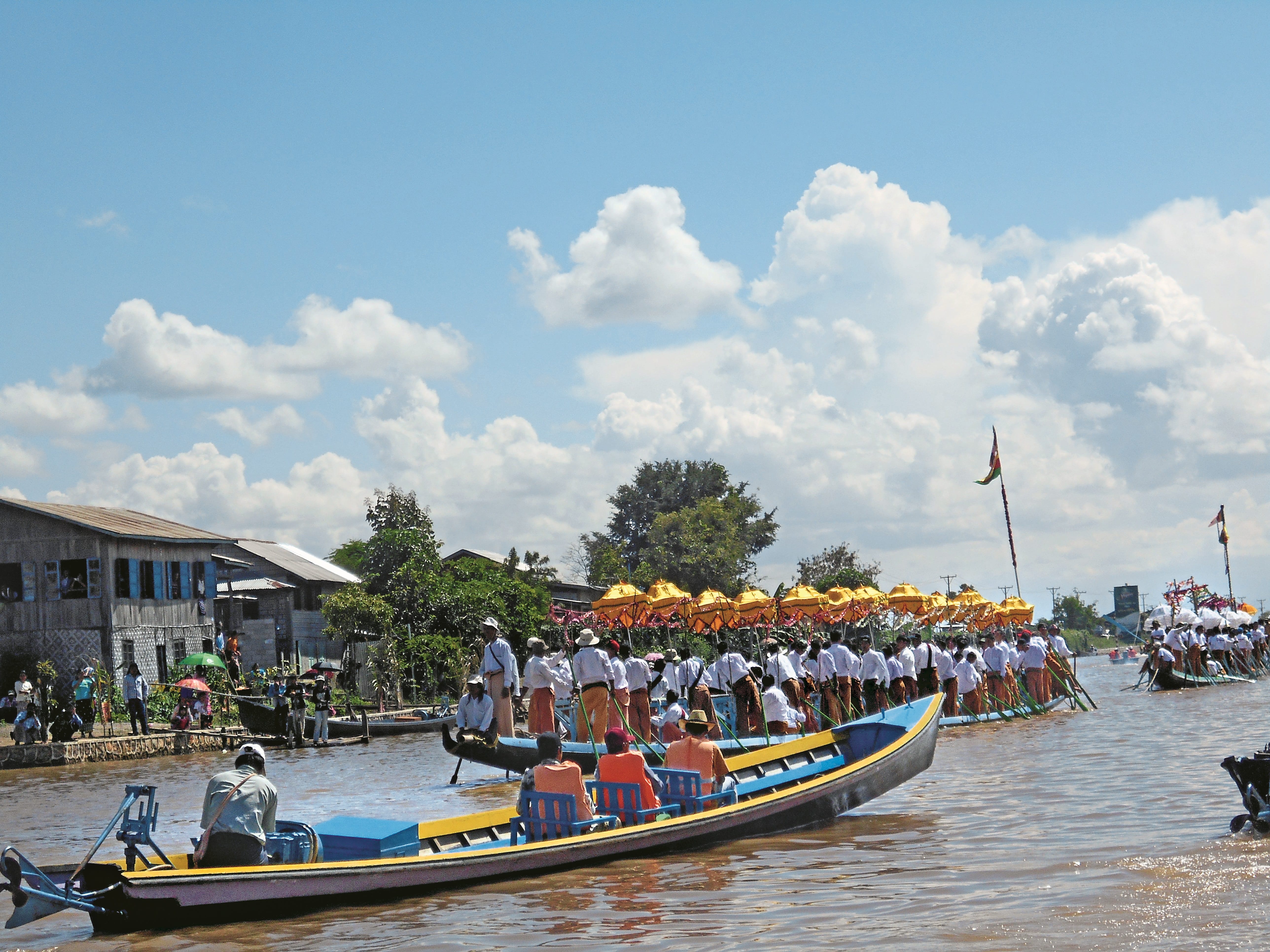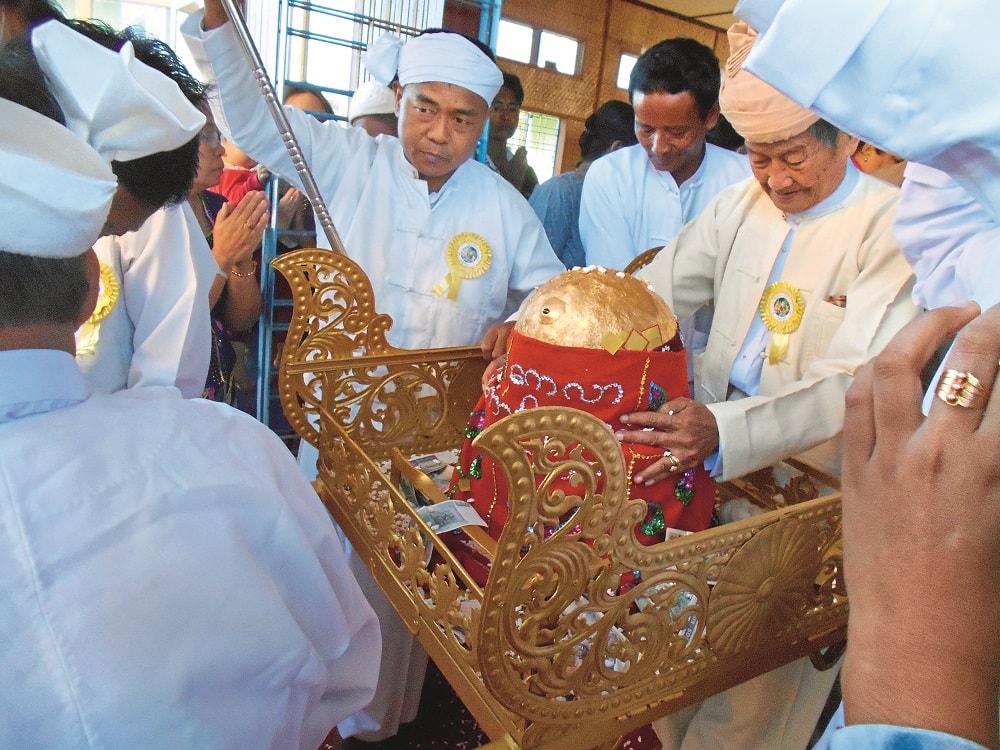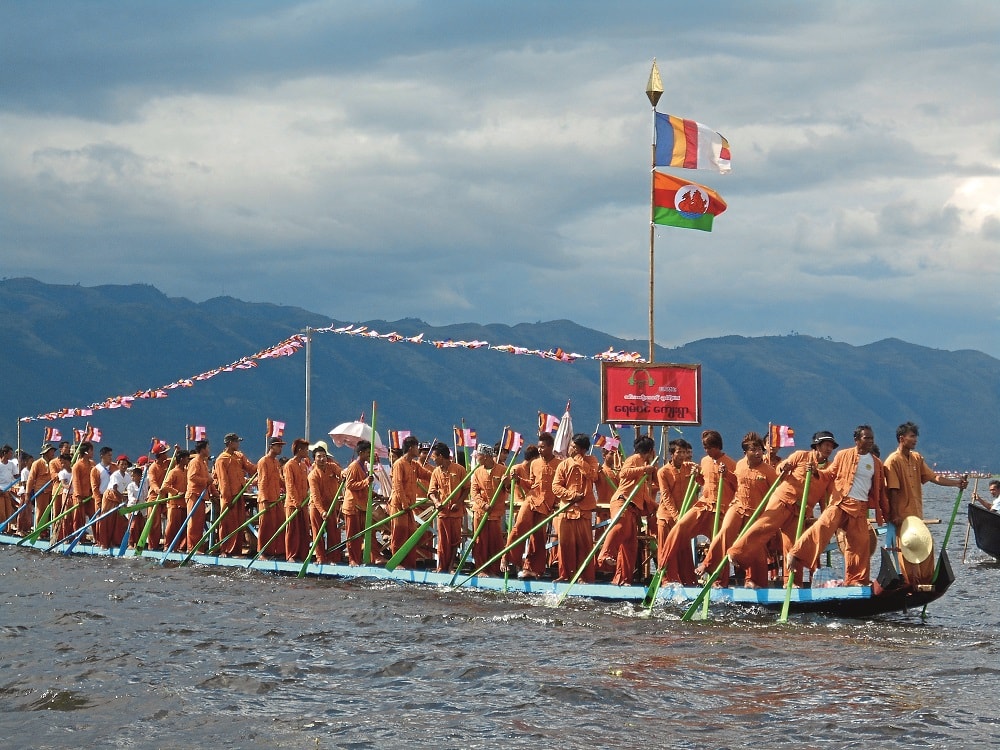The Phaung Daw Oo Buddha Festival takes place every year in September to October on Inle Lake, Southern Shan State, in Myanmar. The festival includes a procession of 36 boats rowed by hundreds of Intha men leading a huge barge in the shape of Myanmar’s mythical Hintha bird also known as the Karaweik. The barge carries four Buddha images around the lake for a total of 26 days so that all the villagers can pay homage.
We joined the procession at Nyaung Shwe where the images had resided for two days. They were carried reverently from the monastery by a group of officials walking on pink lotusstrewn carpets. People thronged both sides of the road as each image on its own palanquin was carried to the quay.
The dignitaries were dressed all in white, with shan trousers, jackets, and gaung baung, which are the special hats they wear for official occasions. Other men held white umbrellas above their heads. Two men helped one very old and dignified man, holding him carefully on either side. I was told he was the sawbwa, the Shan King, whose title used to be hereditary, but the community now chooses a prominent member of the town.
The legend behind this festival
The legends of the Phaung Daw Oo Buddha Festival are fascinating. As with all legends, the details differ butthe essence of the story remains the same. The following is the version as told in an official Burmese handbook.
One of the powerful kings who lived in Pagan in the 11th century was King Alaung Situ. He wanted to be a Buddhist missionary and decided to travel with a boat. He had a lot of power though he was not a Buddha, nor was he a nat (nats are part of Myanmar’s very much alive spirit world). He had power because he was a king. When he pointed his finger, there would automatically be water in a river or canal.
When he was travelling, he met many kinds of people including a good nat who asked the king to stop the boat because he wanted to give the king something special to take to other Buddhists. The nat gave him some wood called tarakan, which is something like sandalwood and has a wonderful smell. The nat told the king he should make a woodcarving image of the Buddha. King Alaung Situ promised he would make five Buddha images with the wood. And so he did.
The king put the five images in the boat and continued his journey. At Inle Lake, he came to Indein village. This village had its own sawbwa. King Alaung Situ gave the Shan sawbwa the five images and they have been held around Inle Lake for over 500 years. All the neighbouring villagers were excited to come and see the images.So the sawbwa decided once a year, from September to October, he would take the Buddha images by boat around the lakeside villages.
On one occasion there was a hurricane with heavy wind and rain. The boat was swamped and one of the images was lost. Try as they might, they could not find it. They did manage to salvage the boat and return to Indein village. Then, when they opened the door of the Phaung Daw Oo monastery, they found the lost image inside. They were very surprised. The sawbwa said the image must have been found by a good nat. So then there were five images as before.
The following year, the sawbwa planned to take the images around the Inle Lake villages again. However, people thought they should leave one image behind to prevent hurricanes. They left the one that had been lost the last time. Ever since then, only four images are carried around each year.
A procession of boats
The images appeared to be heavy as the men lowered them from their palanquins into the boat. However, I was assured they weighed not much more than a kilogram. They are no longer recognisable as statues of the Buddha. They resemble, as one person put it, golden balls. Their rotund almost cuddly appearance is due to the gifts they have been given over the centuries by the population. The gifts are uniformly gold leaf.
In the old days, the Hintha visited six villages in six days staying one night in each. Now the procession visits 22 villages and takes 26 days. It stays a little longer at Nyaung Shwe, because that is where the sawbwa comes from. As well as Nyaung Shwe, the images visit Indein, Heyar, Nanthi, Nampan, Nyaungdaw, and Ywargyibanpone. The Hintha must stay at least one night in each place and at the end of the festival, the images must be returned to the Phaung Daw Oo Pagoda.
At the front of the procession longboats with about 60 men in each are rowing in the distinctive Intha way. They row with one arm and one leg, thus leaving the other arm free to tend their nets when fishing. Along the way, families sit in their boats watching the spectacular flotilla sail past. Some families have brought gifts to offer to the Buddha.
A magnificent barge tows the Hintha. When it nears the village of Mine Thauk, the rope is cut and a good nat will guide the boat into the village. Whether it is really a good nat or a current is unclear.
Boats skim up and down the lake all vying for a good view. Pa-O women, wearing their distinctive green and blue turbans, are chanting prayers in Sanskrit in one boat. School girls are doing the same in another.
The Hintha moves into the main channel heading towards Mine Thauk. Our boatman revs his engine and we race down a different, tiny channel made narrow by enthusiastic water hyacinth that grows all around the edges of Inle Lake. It is a scourge in many parts of the world, but the people here use it and other weeds as a platform for their floating gardens.
We race on and re-enter the main channel in front of the procession, which is now more than a mile long. All the villagers arrive to watch, too. There are now more than 100 boats.
The huge Intha-rowed boats have dancers too. As the 60 rowers pull hard with hand and leg so other men – all men, mind you, no women are allowed on board – are bowing and swaying with graceful hand movements to the sound of traditional music of gongs and cymbals. The younger among them are jigging up and down – less graceful, but more cool. The excitement is palpable.We see something in the sky. Could it be a good nat? (or even a bad nat?) It turns out to be a drone, maybe taking photos, someone suggests.
Men on the boats wear uniforms. All wear Shan pants and tunics, but some have white tunics along with their cinnamon pants. Each boat has coloured umbrellas: some white, some green, and some gold. Usually, gold is reserved for royalty or funerals, but here it is allowed for decoration. Not all the boats are rowed by Intha; Shan boatman row in the usual way, yet they seem just as tired when they pass the entrance to the village at Mine Thauk. They relax on their oars and simply drift to a halt.
Suddenly, black clouds appear overhead. This is the end of the rainy season and because the fifth Buddha image is in the pagoda, we didn’t expect a hurricane. Still it doesn’t hurt to be careful, so after the last boat of the procession passed we turned and made our way back to Nyaung Shwe without so much as a drop of rain.
Judyth Gregory-Smith, nature and travel writer, is the author of Myanmar: A Memoir of Loss and Recovery.
A version of this article was originally published in The Expat magazine (August 2017) which is available online or in print via a free subscription.
"ExpatGo welcomes and encourages comments, input, and divergent opinions. However, we kindly request that you use suitable language in your comments, and refrain from any sort of personal attack, hate speech, or disparaging rhetoric. Comments not in line with this are subject to removal from the site. "






















